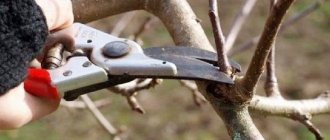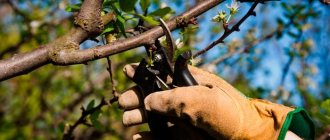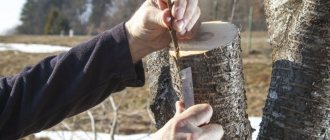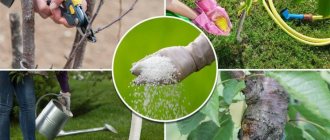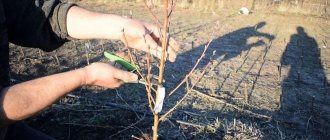Why do you prune an apple tree in the spring?
An apple tree can be pruned in any season - spring or autumn. In the fall, it is customary to do sanitary pruning, but it is recommended to do crown formation only in the spring. In the fall, it is important to prune at a time so that the wounds have time to heal; in the spring there is no such problem - the tree has a whole summer ahead of it to heal the wounds.
Tasks of spring pruning:
- Removal of damaged, old, diseased and frozen branches.
- Removing branches that interfere with the penetration of sunlight to the fruit.
- Uniform distribution of apple tree forces - directing them to productive branches with fruits.
- Pruning branches that are too long - they often break due to the weight of the fruit.
- Removal of young shoots, tops, and competitive branches.
- Correcting pruning mistakes made in the fall.
Lack of proper pruning leads to a decrease in yield and a deterioration in the quality characteristics of the fruits - they become small and take a long time to ripen.
Spring pruning is especially important for young trees, since rapidly growing branches can shift the tree’s center of gravity, bending its trunk.
Content
- 1. Formation of the crown frame of young apple trees
- 2. Pruning fruit-bearing trees
- 3. Rejuvenation of old apple trees
- 4. Do cherry and plum trees need to be pruned?
Among agrotechnical measures for caring for fruit trees, pruning . It does not have a decisive influence on fruiting, but this procedure should not be underestimated. Main purposes of pruning:
- crown formation;
- stimulation of the formation of fruiting shoots.
Gardeners pay the closest attention to their favorite fruit crop - the apple tree . Tree pruning is carried out almost throughout its entire life on the garden plot, but at different age periods of the fruit crop, the method and purpose of this activity differ.
Terms and conditions of pruning
The pruning time is chosen based not on a specific date, but on the climatic conditions in a particular region. When choosing the timing of pruning, it is important to keep within a short time interval suitable for the event - between the awakening of the tree and the formation of buds.
You cannot be late with pruning - it is important to do it 3-4 weeks before the start of sap flow. But there is no need to rush - after winter the wood is very fragile, and very early pruning is harmful to it.
Gardeners choose the pruning scheme at their own discretion, taking into account:
- age and size of the tree;
- workload;
- location of the tree on the site.
During spring pruning of an apple tree, a gardener forms a crown of a certain shape:
- rounded;
- pyramidal;
- flat horizontal;
- flat vertical;
- columnar;
- curly.
When is the best time to prune?
It is advisable to carry out this work at least 2 times a year. The timing of pruning apple trees is very important. A tree that is pruned at the wrong time may become sick, freeze, bear no harvest, or produce very little fruit. Pruning old and young apple trees with a well-formed crown is different, and the methods of formation also differ. The generally accepted deadlines are as follows:
- the main pruning is carried out during the dormant period (after leaf fall - before the start of the growing season) - the procedure is carried out annually in autumn, winter or spring (the optimal period depends on the climatic zone);
- auxiliary (summer) – from July to August.
Preparation
To carry out high-quality pruning, in addition to knowledge or guidance, you need high-quality tools and means for processing cuts.
Tools
To prune fruit trees, you will need a sharp, clean and disinfected tool without traces of corrosion - rust can cause rotting of the branches, and then the entire tree.
Inexperienced gardeners are sure that any construction saw is suitable for pruning. In fact, the job requires a whole arsenal of tools. When pruning in spring you will have to use:
- pruning shears;
- garden knife;
- loppers with rods of different lengths - to remove hard-to-reach branches;
- garden saws with special bends and a narrowing at the end of the blade.
The cuts must be perfectly straight. If you are inexperienced, do some practice pruning before approaching the fruit tree.
Take a bottle of alcohol with you to the garden - clean your tools before work and after each cut branch.
Processing means
To prevent sap from leaking out and infecting the tree, be sure to lubricate the branches with one of the treatments. Can be used:
- garden mastic or garden varnish;
- a solution of copper sulfate and lime in a ratio of 1:10;
- plasticine;
- oil paint.
There is an opinion that trees do not need processing of cuts, they supposedly will recover better this way. Whether to lubricate the cuts or not is up to each gardener to decide for himself.
Trimming schemes
There are two options for spring pruning:
- Thinning. It consists of completely removing some of the branches that interfere with the penetration of sunlight to the fruit. When pruning, a small branch should remain - you cannot cut the branch right down to the trunk, but you also cannot leave a long branch. With this pruning scheme, the tree grows well in the horizontal and vertical directions, and there is no lateral branching in the crown.
- Shortening. Trimming part of the shoot that has grown over the year. After pruning, the branches thicken and side shoots appear on them. With this pruning scheme, growth in height and width is inhibited, but side shoots below the cuts grow faster.
Research results
According to studies conducted in experimental plantings of VNIISPK, with the help of regular pruning, systematic rejuvenation and replacement of overgrowing branches, it is possible to maintain the compact size of the tree with a predominance in the crown of fruit branches no older than 4-5 years, on which the main fruiting is concentrated. The conclusions of experts were made based on a study of the following varieties: “Sinap Orlovsky”, “Northern Sinap”, “Uelsi”, “Orlik”, “Orlovskoe Polosatoe”, “Veteran”.
Annual crown care helps increase the yield and size of apples
Measures such as reducing tree height, limiting crown width and thinning affected both productivity and apple quality. An increase in the average weight of fruits and the number of large ones was noted, which is especially important when growing apple trees with small fruits, such as “Northern Sinap”, “Orlik” and “Veteran”.
Pruning young and adult apple trees
Apple trees are pruned annually. The first time the seedling is pruned in the nursery, leaving from 3 to 5 skeletal branches on the central trunk. The following spring, the apical shoots are shortened, forming lateral branches. Pruning is repeated every spring, but the technique varies depending on the age of the tree. Let's look at how to prune young and mature apple trees.
Annual seedling
A one-year-old seedling planted in the fall is pruned six months later - in the spring. If the seedling is planted in the spring, then pruning is carried out immediately after planting. Thus, already in the first year after planting the tree, its crown is formed. If the tree has the correct structure, it will not need any additional supports in the future - thanks to the balanced relationship between the location of the branches and the number of apples.
Please note that future harvests depend on how correctly the apple tree is pruned in the first spring. The most popular option is a sparse multi-tiered crown.
Step-by-step instructions for pruning an annual seedling:
- Cut the central trunk at a height of 0.8-1.0 m from the ground surface. Due to the shortening of the main conductor, the lateral branches, which will subsequently become skeletal, activate their growth.
- Remove all buds and branches (if any) in the trunk area - from the surface of the ground to the first tier of skeletal branches.
- If the seedling has already acquired branches, mark those from which the first tier will be formed. 3-5 branches are enough - they should be directed in different directions so that the tree is symmetrical and balanced. If there are no branches yet, add 5-8 buds for the first tier (take more than you need - in reserve).
- Remove any branches that form an angle less than 45 degrees with the trunk. If left, they will break off either during a storm or under the load of fruit.
- Cut branches that will be skeletal to 30-40 cm, shortening them by 3-5 buds.
When pruning excess branches, be sure to leave those that are located at a large angle. Such branches are distinguished by their strength and productivity.
When choosing the height of the first tier of skeletal branches, keep in mind that a trunk that is too low will make it difficult to care for the tree, and a trunk that is too high will be susceptible to sunburn.
The first spring pruning is an urgent necessity. Even with the most careful planting, the root system of a seedling is damaged. By pruning the branches, the gardener optimally distributes nutrients in the tree.
Two-year-old seedling
When pruning a two-year-old seedling, follow the rules similar to those for working with one-year-old trees. Of all the available branches, leave those that are suitable for forming a reliable structure of the apple tree. Form the crown from 3-5 strong skeletal branches, remove all others. Please note that the conductor is located above all other branches by 4-5 buds, which corresponds to approximately 30 cm.
Instructions for pruning a two-year-old seedling:
- Form a tiered crown by cutting the lower and upper branches to different sizes. The lower branches should be longer than the branches of the upper tier by about 25-30 cm. Pruning the shoots from which skeletal branches will form stimulates branching.
- Shorten the branches growing between the tiers and bend them at an obtuse angle so that they bear fruit faster. If you then select a tiered crown, remove them.
- If the top is forked, then remove the weaker branch from the two branches. You can also make a skeletal branch from an extra branch, transferring it by stretching it to the second or third tier.
The skeletal branches should extend from the central conductor at an angle of 60-90 degrees, no less.
When pruning young apple trees, excess side branches are removed gradually. They are left temporarily so that a stable trunk expanding downwards is formed.
In the video below you can see the correct pruning of young seedlings to form a crown:
fruit tree
When pruning fruit-bearing apple trees, it is recommended to shorten the main branches in order to slightly slow down the growth of the tree. If it spends energy on growing branches, there will be less nutrients left for the fruits. With a correctly formed crown, there will be no special work with spring pruning.
Features of pruning fruiting apple trees:
- Inspect the crown and remove branches that thicken it.
- Trim off all the tops. Vertical growths only disturb the tree - they absorb its strength and prevent the sun from penetrating to the fruits.
Rejuvenation of old wood
30 years for an apple tree is not a death sentence. Thanks to anti-aging pruning, the productive life of a fruit tree can be extended. By removing everything unnecessary, old and rotten, you will rid the garden of branches in which infection and pests can hide. Rejuvenating pruning makes sense if the old tree has a trunk that is not damaged and has several strong skeletal branches. Old apple trees are pruned every 2 years.
Features of anti-aging pruning:
- Remove shoots that shade fruiting branches.
- Remove branches growing inward.
- Trim the top of the trunk at a height of 3 m to leave the crown open.
- Trim dead and damaged branches.
- Remove unpromising branches and you will increase the yield of an old apple tree.
- Next year, during spring pruning, remove skeletal branches that interfere with fruiting branches.
During anti-aging pruning, 1/3 of all branches and shoots are cut out. Most likely, there will be no special harvest this year. In order for renewal processes to begin in the tree, the tree will have to be rejuvenated again over the next two years.
Working with trees on a trellis
It is easy to collect fruits from apple trees formed on wire trellises. Rules for pruning a tree on a trellis:
- To ensure that the tree grows in one plane, direct the strongest branches in opposite directions. The angle of deviation from the central trunk is straight or obtuse.
- Shorten the conductor at a distance of 0.5 m from the branches.
- After a year, repeat the pruning pattern - the side branches are fixed horizontally. Trim weakened branches and competitive apical shoots. Similarly to the previous year, shorten the conductor.
- In summer, lift the young apical shoots of the lateral fixed branches upward with stretchers so that they do not lag behind in growth from the central trunk.
- Form the third tier in the same way as the previous diagram - secure powerful branches, cut off vertical and weakened branches. If you are forming the 4th tier, cut the conductor or tilt it at a right angle, creating the last horizontal line.
Efforts to form the crown are not wasted - espaliered apple trees look very beautiful. Such trees reach a height of 1.8 m on low-growing rootstocks, and 2.5 m on strong-growing rootstocks.
How to prune espaliered apple trees is shown in the following video:
Pruning dwarf trees
Dwarf apple trees need pruning no less than ordinary ones. But it is carried out in express mode. First, sanitary pruning is done, removing all broken and weakened branches. At the same time, the crown of the tree is formed. Pruning of dwarf apple trees begins in the first spring.
Step-by-step instructions for pruning a dwarf apple tree:
- In the first spring, shorten the main shoot at a height of 0.5 m from the ground surface. Make the cut above the bud - in the direction opposite to the graft. As a result of such pruning, by autumn, 4 shoots should appear on the tree - the vertical one will become a conductor.
- In the second spring, cut off the top, retreating 20 cm from the base. Trim the side shoots in the same way - at a distance of 20 cm.
- Trim off any excess side shoots. Trimming level – 3rd sheet.
- In the third spring and all subsequent springs, prune the tree in the same way as in the second spring.
- Once the dwarf tree has grown to your desired height, remove the growing section of conductor annually. Cut off the side shoots when their length exceeds 40-50 cm.
- Perform sanitary pruning every year.
- To keep the main branches horizontal, trim their growth towards the ground.
We recommend reading the article about spring grafting of apple trees.
young tree
Pruning 3-5 year old seedlings takes minimal time. Pruning, although minimal, is extremely important for apple trees beginning to bear fruit.
Instructions for pruning young apple trees by year:
- Third spring: Shorten the shoots in the second tier - by 10-15 cm.
- Trim the growth of skeletal branches by 10 cm.
- If you want, you can leave a few skeletal background branches. Also shorten them by 10-15 cm.
- Remove all branches that compete with the main conductor and with the conductors of the skeletal branches. Trim off any growth on them as well.
- Shorten the central conductor by 1/3 or 1/4 so that the one-year part does not exceed 60 cm in length.
- Select a strong branch with a wide branch angle. It should be 50 cm above the second tier.
Crown formation is completed in the 6th year. For the sixth spring, it remains to select one more skeletal branch in the 2nd tier. In the following springs, thin out the crown and remove excess shoots.
An experienced gardener shows how to prune a young apple tree in the spring in his video below:
Basic principles of crown formation
Proper pruning makes it possible to form the optimal shape of the apple tree crown for specific conditions, ensure better and faster growth of the tree, and increase the yield and quality of apples. Regular pruning encourages trees to bear fruit regularly, produces an adequate amount of fruiting wood and (if necessary) increases the proportion of young shoots. Apple and pear trees have mostly short fruiting shoots.
Tools: pruning shears, loppers, garden saw
However, not everyone knows how to prune apple trees. Below are some rules for pruning apple trees that you should definitely pay attention to:
- We get rid of unnecessary branches. First remove branches growing at sharp angles; they break faster under the weight of the fruit.
- Trim branches that unnecessarily shade others, cross, or fall on neighboring branches.
- Remove branches that compete with the center and side conductors.
- When forming the crown of an apple tree, you need to get rid of shoots and branches that are diseased or attacked by pests.
- Apple trees, especially vigorous varieties on tall rootstocks, form very tall crowns. Trees with too high a crown should be limited - caring for tall trees is difficult and inconvenient. It is easier to limit trees on low- or medium-growing rootstocks, which must be taken into account when purchasing seedlings.
- With severe pruning, strong shoots begin to appear, protruding vertically upward, which are usually called “tops”. These shoots should be removed every year because they can cause severe compaction and shading of the crown. It is better to remove the “tops” in the summer – the wounds will heal faster.
- It is better to carry out work on dry days so that the wounds dry out faster.
- Branches can only be trimmed with disinfected tools to prevent trees from becoming infected with diseases. Especially after pruning diseased trees.
- Wounds that form after removing thick branches should be properly protected from possible attack by pathogens and excessive drying. In gardening stores you will find suitable products, for example, copper-based. They also use garden pitch and oil paint on drying oil.
Apple tree care after pruning
After pruning, the apple tree needs care:
- Treat each cut using one of the products described above - preferably garden varnish or a solution of copper sulfate.
- Regularly remove weeds and loosen the soil in the tree trunk circle to allow air to flow to the roots.
- Mulch the soil near the tree with a layer of rotted manure. Layer thickness – 3 cm.
- During the growing season, treat the tree with fungicides and insecticides - drugs against diseases and pests.
Every gardener should know what diseases apple trees have, so this article may be useful to you.
Slices
When pruning your apple tree, make sure you cut in the correct position. When removing a branch, always cut it just past the end of the branch collar, as shown in the apple tree pruning photo.
A branch collar is a ring of woody plant tissue at the junction of an apple tree branch and the trunk. Make sure your cut is on the branch you want to remove and not the parent branch.
- Cuts are made to reduce the height or length of a branch. When you make these cuts, the next bud on the branch will grow significantly and become a leader in the coming growing season.
- We can take advantage of this by cutting in front of the bud that faces in the direction we want the branch to grow. We usually cut just before a bud facing outwards or downwards as this will encourage the tree to grow outwards.
Popular beginner mistakes
Pruning is an event that requires certain knowledge; even experienced gardeners often make mistakes, especially since beginners are not immune from them. Try to avoid common mistakes among gardeners:
- Don't leave stumps. Make circular cuts so that the tree itself heals the wound.
- Do not randomly shorten the apical conductor of a young seedling - this leads to the appearance of several shoots at the top, which weaken the lateral ones.
- Do not use tools that have not been sharpened or disinfected. This error leads to the formation of burrs in the bark, which prevents the healing of wounds.
Methods for cutting shoots and branches
There are the following methods for pruning apple tree branches:
- on the ring;
- on the kidney;
- stepped (for large branches).
On the ring
At the base of the branches, a ring-shaped influx of bark is clearly visible, consisting of active tissues that can relatively quickly close the wound with new bark. When the branch is completely removed, the so-called “ring” pruning is carried out to the ring.
How to make a cut correctly:
- The branch is cut exactly along the top of this annular bead at a slight angle.
- You cannot cut off the ring by going deep into the wood, as this will remove the most active bark tissue and the wound will take longer to heal.
- You cannot leave a stump above the ring, otherwise the tree will not be able to cover the wound with bark or will take a long time to overgrow, and the wood may begin to rot at the cut site if the branch is large.
On the kidney
The method is used when shortening annual shoots during crown formation. Correct pruning for a bud is done like this: the cut is made above the bud, which “looks” outside the crown so that the shoot growing from it does not thicken the tree. Some gardeners prune to the inner bud; this leads to thickening of the crown and worsens the air and light conditions of the tree.
Scheme. The figure shows: the inner bud “looks” into the crown and the outer bud “looks” out from the crown.
Stepped
It is used when you need to cut down a large, heavy branch. To prevent the branch from breaking off when cutting, creating a large wound on the trunk, it is sawed in several stages:
- First, an incision is made at a distance of several centimeters from the ring, with a depth of about a third of the thickness of the branch.
- Then an incision is made at the top of the branch at a distance from the ring a little further from the bottom cut. As a result, the branch is cut without breaking or injury.
- The remaining stump is cut into a ring with a hacksaw. Cutting a large branch creates a large wound; it needs to be treated with garden varnish.
Advantages and disadvantages
Spring pruning is a mandatory event with many advantages:
- Forms a beautiful crown.
- Strengthens the trunk and branches.
- Increases light penetration to fruits.
- Frees from damaged branches.
- Prevents the development of diseases.
- Reduces the number of apple pest larvae.
- Allows you to get the desired number of fruiting branches.
- Rejuvenates old branches and increases the strength of young branches.
There is only one drawback to spring pruning - the difficulty of determining the optimal timing. Gardeners have to rely on the weather and their intuition.
Proper spring pruning will allow you to grow a beautiful, strong and productive tree from a small seedling. Remember that pruning is especially important in the first years of life, so prepare carefully for the event, study the instructions, sharpen the tool and grab a garden varnish.
0
0
Copy link
